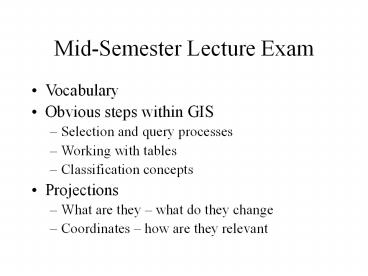Mid-Semester Lecture Exam PowerPoint PPT Presentation
Title: Mid-Semester Lecture Exam
1
Mid-Semester Lecture Exam
- Vocabulary
- Obvious steps within GIS
- Selection and query processes
- Working with tables
- Classification concepts
- Projections
- What are they what do they change
- Coordinates how are they relevant
2
Home Work 1
Dealing with an exchange format
- In ArcToolBox
- Coversion Tools
- Import to coverage
- Import from interchange file
- Define projection for coverage
- In ArcMap
- Data
- Export to shapefile
- Project shapefile to whatever you want
3
- Data types raster vs. vector
- How does GIS differ from a mapping or CAD package
- The three basic components of ArcGIS
- Define vs Projection
- Metadata
- More questions about coordinates
- What information is critical for a coordinates to
be relevant? - Cardinality
- When do you use a join and when relate?
4
Tables Continued
- Adding Fields and Records
5
There are several data types
- There are two basic types common used
6
Data Types
It is very important to choose the right data
type.
7
ArcGIS can handle several tabular data formats
- Coverages use an INFO format. These are an older
format, cumbersome, but still frequently used. - A shapefile uses a .dbf format. Much more
sophisticated than an INFO file. We are
currently using .dbf files in the lab exercises. - Geodatabases uses a RDBMS format. Very
sophisticated and powerful but more complex. We
will use them in a few weeks time.
8
Very often you need a new field in a table.
9
Specify the Name and the Data Type
Integers No Decimals
-32,000 to 32,000
-2 billion to 2 billion
10
Numbers with Decimal Places
Precision is the number of digits to be stored.
Scale is the number of decimal places.
11
Date
Text
It is important to specify a length to
accommodate your attribute but not too long.
12
Calculating a Value
13
(No Transcript)
14
The selected records are assigned the calculated
value
Notice that text values are enclosed in double
quotes
15
Calculating a Numeric
16
Convert from one data type to a different data
type
Text type
Numeric type
17
Add a new numeric FIPS field then calculate the
text field as a numeric field.
18
Create a New Table
19
(No Transcript)
20
Open the new table in ArcMap and then add data
21
You can use ascii files
PowerShow.com is a leading presentation sharing website. It has millions of presentations already uploaded and available with 1,000s more being uploaded by its users every day. Whatever your area of interest, here you’ll be able to find and view presentations you’ll love and possibly download. And, best of all, it is completely free and easy to use.
You might even have a presentation you’d like to share with others. If so, just upload it to PowerShow.com. We’ll convert it to an HTML5 slideshow that includes all the media types you’ve already added: audio, video, music, pictures, animations and transition effects. Then you can share it with your target audience as well as PowerShow.com’s millions of monthly visitors. And, again, it’s all free.
About the Developers
PowerShow.com is brought to you by CrystalGraphics, the award-winning developer and market-leading publisher of rich-media enhancement products for presentations. Our product offerings include millions of PowerPoint templates, diagrams, animated 3D characters and more.

